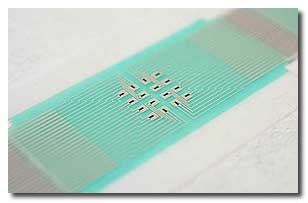|
Scientists have created a non-invasive adhesive
patch which promises to measure glucose levels
without a finger-prick test. The patch does
not pierce the skin, instead it draws glucose out
from fluid between cells across hair follicles,
which are individually accessed via an array of
miniature sensors using a small electric current.
The glucose collects in tiny reservoirs and is
measured.

Readings can be taken every 10 to 15 minutes over
several hours.
Crucially, because of the design of the array of
sensors and reservoirs, the patch does not require
calibration with a blood sample – meaning that
finger prick blood tests are unnecessary.
Having established proof of the concept behind the
device in a study published in Nature
Nanotechnology, the research team from the
University of Bath hopes that it can eventually
become a low-cost, wearable sensor that sends
regular, clinically relevant glucose measurements to
the wearer’s phone or smartwatch wirelessly,
alerting them when they may need to take action.
An important advantage of this device over others is
that each miniature sensor of the array can operate
on a small area over an individual hair follicle –
this significantly reduces inter- and intra-skin
variability in glucose extraction and increases the
accuracy of the measurements taken such that
calibration via a blood sample is not required.
This path-selective, non-invasive, transdermal
glucose monitoring system based on a miniaturized
pixel array platform (realized either by graphene-based
thin-film technology, or screen-printing) samples
glucose from the interstitial fluid via
electroosmotic extraction through individual,
privileged, follicular pathways in the skin,
accessible via the pixels of the array.
A proof of principle using mammalian skin ex vivo is
demonstrated for specific and ‘quantized’ glucose
extraction/detection via follicular pathways, and
across the hypo-to hyper-glycaemic range in humans.
Furthermore, the quantification of follicular and
non-follicular glucose extraction fluxes is clearly
shown.
When Dr. Adelina Ilie's team, from University of
Bath, UK, tested in two healthy human volunteers,
the device provided glucose results that closely
matched levels measured in the blood, researchers
reported in Nature Nanotechnology.
In vivo continuous monitoring of interstitial
fluid-borne glucose with the pixel array was able to
track blood sugar in healthy human subjects.
This approach paves the way to clinically relevant
glucose detection in diabetics without the need for
invasive, finger-stick blood sampling.
The researchers stress that the device needs further
development before it becomes a wearable, simple,
blood-free way to measure blood sugar levels.
For more information
nature nanotechnology
Non-invasive, transdermal, path-selective and
specific glucose monitoring via a graphene-based
platform
Link...
University of Bath
Link...
MDN |